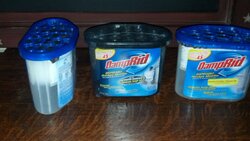After 2 seasons of not doing anything for moisture control in the off season and dealing with the oxidation that has resulted I decided to do something different this year. In addition to covering up the exhaust and oak I want to use some type of desiccant. I started looking around online at different options.Seems like the two best choices are silica gel and damprid. Silica gel is silica gel and damprid is what? I read the MSDS sheet on it and it turns out its calcium cloride. So my decision is not made but I do have a 50lb bag of calcium cloride flakes for melting ice....
What's everybody else using?
What's everybody else using?


 but will get some .
but will get some . don't know why they didn't do them the same way. I have only dumped my ash pan once this year. I wait till the ash is over the pot (pretty close to being the 2nd time to dump
don't know why they didn't do them the same way. I have only dumped my ash pan once this year. I wait till the ash is over the pot (pretty close to being the 2nd time to dump 